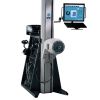
Get Ahead of the Game With Prehab
Treatment GuidelinesPrehab can reduce overall recovery time and cost, ease post-op complications and anxiety, and change discharge destination – and that’s just the patient benefits. For your clinic, prehab is a reimbursable revenue stream that encourages return visits to your clinic.
Prehab reduces patient anxiety, hospital stay, recovery time, and cost, and increases patient satisfaction, clinic revenue, and return visits.
As clinicians, we’ve seen multiple patients struggle with the same post-op issues. We know what issues to expect after certain surgeries, but wouldn’t it be better to start working with patients even before the surgery? Prehabilitation visits address recovery concerns before surgery.
Prehab can reduce overall recovery time and cost, ease post-op complications and anxiety, and change discharge destination – and that’s just the patient benefits. For your clinic, prehab is a reimbursable revenue stream that encourages return visits to your clinic. Let’s take a look at the benefits of prehab.
What is prehab?
In general, prehab aims to increase physical activity and improve physical fitness prior to surgery. Some refer to it as physical optimization, which is actually prehab specifically for deconditioned patients. Prehab can benefit patients of almost any condition going into surgery.
A prehab program should address existing deficits as well as issues that may impact post-op recovery and outcomes. Prehab often involves one or some of the following interventions:
- cardiovascular training
- therapeutic exercise including progressive resistance training of extremities and/or total body, stretching, flexibility, range of motion
- proprioceptive and balance training
- progressive functional activity training
- pain management
- heat and/or ice
- neuromuscular electric stimulation (NMES)
- home exercise program of the above
Following up with rehab visits after surgery, it’s helpful to practice common movements, such as:
- gait training, including stairs
- bed mobility and transfers
- pain management
- education
- post-op precautions related to joint replacement (practice in clinic)
- post-op activities for home exercise program
- assessment of return to home (necessary equipment and assistive devices, adaptations needed to home environment, safety issues, need for assistance from someone)
Prehab reduces hospital stay, recovery time, and cost
Overall, prehab shortens a patient’s recovery time. If you train and strengthen the muscles beforehand, they will need less recovery time after the surgery.
Studies show that patients participating in prehab had shorter hospital stays and recovery times than patients without prehab. Reducing hospital and recovery time helps keep costs down for patients.
When patients are ready to discharge from the hospital, their recovery status determines whether they’ll be allowed to return home with home health and/or outpatient rehab, or potentially have to go to a skilled nursing facility for further recovery.
Prehab can help patients avoid costly in-patient recovery facilities. Patients who had prehab visits before surgery are more likely to be discharged home with outpatient rehab. For those that require in-patient recovery services, prehab still reduces the amount of time needed to make a full recovery at these facilities.
Prehab reduces anxiety, and improves overall satisfaction
Studies show that prehab education can reduce patient anxiety. Prehab education is key to boosting patient engagement, which is shown to enhance overall satisfaction. It equips patients with a realistic expectation of surgical outcomes, improves patient satisfaction regarding outcomes, and enhances patient motivation to follow recommendations.
Patient satisfaction and perception in the first month after surgery is key. If patients see good outcomes early, they feel more confident and optimistic throughout their recovery. A rapid recovery also has a significant effect on patients’ mood, and contributes to faster return to their normal life and activities.
Returning to their ADLs and habits without caregiver assistance results in higher patient satisfaction and reduced economic impact of the healthcare system. Follow up with patients by phone, email, etc. before and immediately after surgery. Request a “status report,” and address their questions.
Prehab + your clinic = reimbursement and returns
Starting prehab services at your clinic is a promising way to build a new stream of reimbursable revenue. It is based on sound theoretical principles, and the emerging evidence is encouraging. If patients have a good prehab experience at your clinic, they are likely to return for any recovery services following the surgery.
Several payers, including Medicare, reimburse for prehab services. Clinics can code prehab as Therapeutic Activity or Therapeutic Exercise, or both, depending on the specific patient case. Remember that, as of the 2018 CPT code update, Medicare pays an average of $10.30 more per unit for Therapeutic Activity (CPT code 97530) than for Therapeutic Exercise (CPT code 97110). Click here to learn how your clinic can optimize treatments and CPT coding for higher reimbursement!
Some patients will require multiple visits to address identified deficits and issues. Others may require few visits that address an appropriate home exercise program, assessment of return to home and education related to post-op precautions, exercises, and activities. Check with payers to determine allowable number of visits for prehab.
Keep in mind that the program should be tailored to each individual patient. Include what is medically necessary as defined by your evaluation (which will serve as the patient’s baseline upon return post-op).
Prehab according to research
Current literature supports use of prehab for patients undergoing cardiac surgery, abdominal surgery, and cancer treatment. The literature is not as supportive of prehab for total joint replacement, with studies having small sample sizes, small to medium effect sizes, and/or underpowered statistical models. However, certain cases show promising results.
Total knee arthroplasty (TKA) often results in surgical site pain, weakness, trouble with muscle activation, gait abnormalities, increased risk for falls, anxiety, and other conditions. Prehab has proven successful in improving TKA patients’ post-op experience. Cited benefits include increased strength of affected leg, decreased leg strength asymmetry, and increased ability in performing functional tasks prior to TKR.
These improvements confer both short- and medium-terms benefits after surgery. Other results include a faster range of motion recovery, shorter time in hospital and in-patient rehab, reduced need for in-patient rehab, and improved overall quality of life.
Prehab for your patients
Prehab programs benefit both patients and clinics in important ways. Patients enjoy reduced hospital stay, recovery time, anxiety, and overall cost, as well as enhanced confidence, satisfaction, and rehab outcomes. Clinics get increased revenue from repeat patient visits for reimbursable hours. If your clinic wants to add a profitable service that improves patients’ outcomes and experience, then prehab is the way to go.
Janna Jacobs, PT, CHT, CEAS, CDP
Senior Clinical Research Specialist
BTE
References
- Clode NJ, Perry MA, Wulff L: Does physiotherapy prehabilitation improve pre-surgical outcomes and influence patient expectations prior to knee and hip joint arthroplasty? Int J Ortho Trauma Nursing. 2018;30:14-19. https://pubmed.ncbi.nlm.nih.gov/29954717/
- Gill SD, McBurney H. Does exercise reduce pain and improve physical function before hip or knee replacement surgery? A systematic review and meta-analysis of randomized controlled trials. Arch Phys Med Rehabil. 2013;94:164-176. https://pubmed.ncbi.nlm.nih.gov/22960276/
- Moyer R, Ikert K, Long K, et al. The value of preoperative exercise and education for patients undergoing total hip and knee arthroplasty: A systematic review and meta-analysis. J Bone Joint Surg Rev. 2017;5:e2. DOI:10.2106/JBJS.RVW.17.00015. https://pubmed.ncbi.nlm.nih.gov/29232265/
- Skoffer B, Maribo T, Mechlenburg I, et al. Efficacy of preoperative progressive resistance training on postoperative outcomes in patients undergoing total knee arthroplasty. Arthritis Care Res. 2016;68:1239-1251. https://pubmed.ncbi.nlm.nih.gov/29232265/
- Skoffer B, Dalgas U, Mechlenburg I. Progressive resistance training before and after total hip and knee arthroplasty: a systematic review. Clin Rehabil. 2015;29:14-29. https://pubmed.ncbi.nlm.nih.gov/24994766/
- Soeters R, White PB, Murray-Weir M, et al. Preoperative physical therapy education reduces time to meet functional milestones after total joint arthroplasty. Clin Ortho Relat Res. 2018;476:40-48. https://pubmed.ncbi.nlm.nih.gov/29529614/
- Wang L, Lee M, Zhang Z, et al. Does preoperative rehabilitation for patients planning to undergo joint replacement surgery improve outcomes? A systematic review and meta-analysis of randomized controlled trials. British Med J Open. 2016;6:e009857. DOI:10.1136. https://bmjopen.bmj.com/content/6/2/e009857





